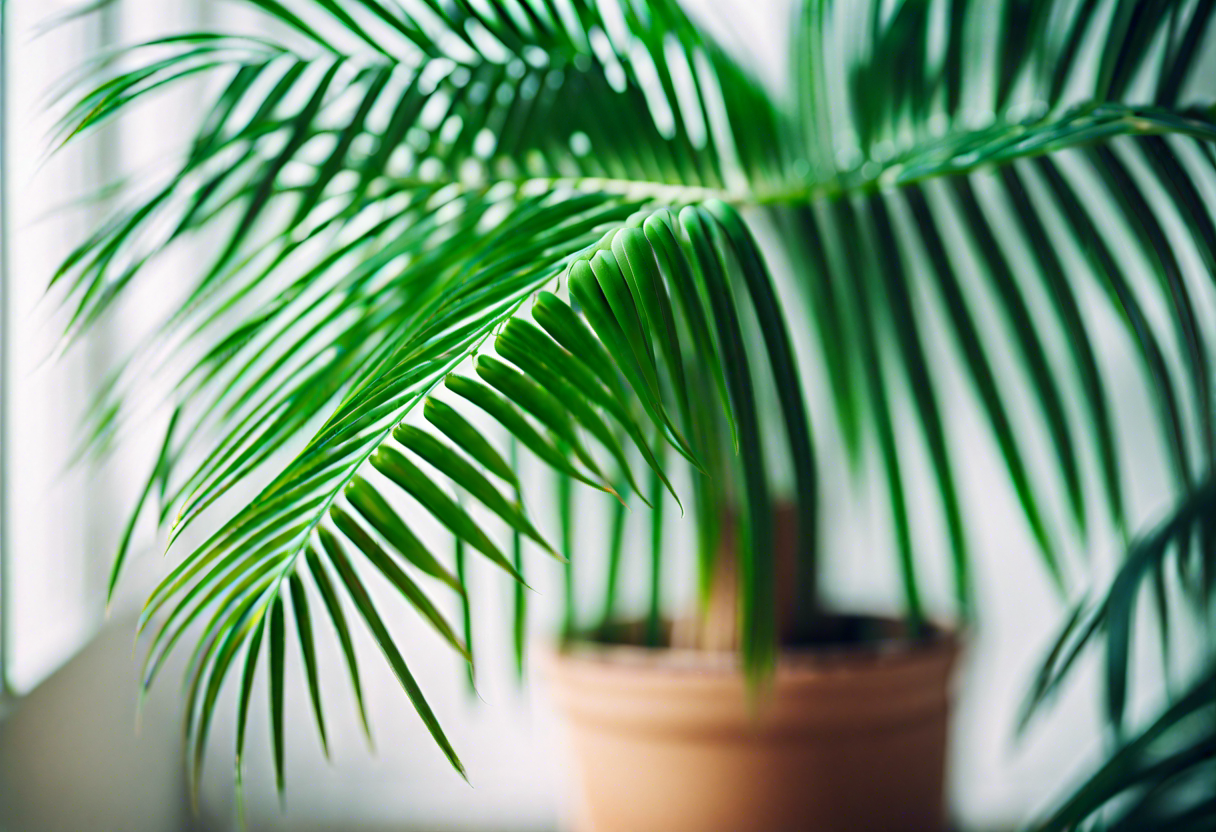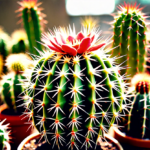Parlor Palm (Chamaedorea elegans) Plant Profile
The Parlor Palm, scientifically known as Chamaedorea elegans, is a popular indoor plant that is cherished for its ability to thrive in low-light conditions. With its graceful, arching fronds and compact size, the Parlor Palm adds a touch of tropical elegance to any space. Let’s take a closer look at its plant profile to understand how to best care for this beautiful plant.
This palm species is native to the rainforests of Mexico and Guatemala. It belongs to the Arecaceae family and is commonly known as the Parlor Palm, Neanthe bella Palm, or the Good Luck Palm. The Parlor Palm features slender, cane-like stems that are topped with lush, dark green fronds. It typically grows to about 2 to 6 feet in height, making it a perfect choice for tabletops, shelves, or compact corners.
When it comes to the Parlor Palm’s preferred growing conditions, it thrives in temperatures between 60°F and 85°F (15°C and 29°C). It is adaptable to various light conditions, but it prefers bright, indirect light. Avoid placing it in direct sunlight as it can scorch the delicate fronds. If the light is too low, the plant may still survive but may grow at a slower pace.
As for watering and humidity requirements, the Parlor Palm appreciates consistently moist soil. Water the plant thoroughly when the top inch of soil feels dry, but be sure not to overwater it. Overwatering can lead to root rot and other issues. Additionally, this palm enjoys medium to high humidity levels. Mist the fronds regularly or place the plant on a humidity tray filled with water and pebbles to increase the moisture in the air.
Fertilizing the Parlor Palm is essential to keep it healthy and thriving. During the growing season, which typically spans from spring to summer, feed the plant with a balanced liquid fertilizer every two to four weeks. Reduce the frequency to once every two months during the fall and winter months when the plant’s growth slows down. Pruning is not necessary for the Parlor Palm, but removing any yellow or brown fronds can help maintain its aesthetic appeal.
When it comes to pests and diseases, the Parlor Palm is relatively resistant. However, it can occasionally attract spider mites, mealybugs, or scale insects. Regularly inspect the plant for any signs of infestation and address the issue promptly. Wiping the fronds with a damp cloth or using insecticidal soap can help control these pests.
The Parlor Palm (Chamaedorea elegans) is a versatile and attractive indoor plant that adds a touch of tropical beauty to any space. By providing it with the right growing conditions, proper watering and fertilizing, and addressing any pest issues promptly, you can enjoy the lush beauty of this palm for years to come.
Optimal Growing Conditions for Parlor Palm
When it comes to caring for your Parlor Palm (Chamaedorea elegans), providing the optimal growing conditions is crucial for its health and overall well-being. This beautiful tropical plant thrives in specific environmental conditions, and by understanding and replicating these conditions, you can ensure the success of your Parlor Palm in your home or office.
Light is one of the key factors to consider when growing a Parlor Palm. While these plants can tolerate lower light levels, they still require bright, indirect light to thrive. Placing your Parlor Palm near a north or east-facing window is ideal, as it will receive plenty of indirect sunlight throughout the day. Avoid exposing the plant to direct, harsh sunlight, as this can scorch the leaves.
In addition to light, the temperature and humidity levels are crucial for the Parlor Palm’s well-being. These plants prefer temperatures between 65-80°F (18-26°C) during the day and slightly cooler temperatures at night. Avoid placing your Parlor Palm near drafts or air conditioning vents, as sudden temperature changes can cause stress to the plant. Maintaining a consistent temperature will help promote healthy growth.
Humidity is another important consideration when it comes to Parlor Palm care. These plants prefer higher humidity levels, similar to their natural tropical habitat. If your home has dry air, consider using a humidifier or placing the plant on a pebble tray filled with water. Misting the leaves regularly can also help increase humidity around the plant. Just be careful not to mist excessively, as this can lead to fungal diseases.
When it comes to watering your Parlor Palm, it’s essential to strike a balance. Overwatering can lead to root rot, while underwatering can cause the leaves to turn brown and crispy. Allow the top inch of soil to dry out before watering, and ensure proper drainage to prevent water from sitting in the pot. Water thoroughly, but avoid letting the plant sit in standing water.
Fertilizing your Parlor Palm is necessary to provide it with the nutrients it needs to thrive. Use a balanced, water-soluble fertilizer specifically formulated for houseplants. During the growing season (spring and summer), fertilize your Parlor Palm once a month. During the dormant period (fall and winter), you can reduce the frequency to every two months.
Pruning is not typically required for Parlor Palms, but you can remove any yellow or brown leaves to maintain its aesthetic appeal. Trim damaged or dead fronds close to the stem using clean, sharp pruning shears. Avoid removing too many healthy leaves, as this can stress the plant.
When it comes to pest and disease control, the Parlor Palm is relatively resilient. However, it can still be susceptible to spider mites and mealybugs. Regularly inspect the leaves for signs of pests, such as webbing or white cottony clusters. If detected, treat the infestation promptly with insecticidal soap or neem oil.
By providing the optimal growing conditions, you can enjoy a thriving and lush Parlor Palm in your space. Remember to monitor the light, temperature, humidity, watering, fertilizing, and pest control regularly, and make adjustments as necessary to ensure the health of your beloved Parlor Palm.
Watering and Humidity Requirements for Parlor Palm
Proper watering and humidity levels are crucial for the health and vitality of the Parlor Palm (Chamaedorea elegans). As a tropical plant, it requires specific conditions to thrive. By providing the right amount of water and maintaining adequate humidity, you can ensure that your Parlor Palm remains lush and healthy.
Watering:
The Parlor Palm prefers to be consistently moist but not drenched. It is important to strike a balance between underwatering and overwatering, as both can be detrimental to the plant’s well-being.
When watering your Parlor Palm, it is best to wait until the top inch or two of the soil feels slightly dry before watering again. This will prevent waterlogged roots, which can lead to root rot and other issues.
Ensure that the pot your Parlor Palm is planted in has drainage holes to allow excess water to escape. Use a well-draining potting mix to promote good drainage and prevent waterlogged soil.
During the growing season, which typically occurs during spring and summer, you may need to water your Parlor Palm more frequently. As the weather cools down in fall and winter, reduce the frequency of watering, allowing the soil to partially dry out between waterings.
Humidity:
The Parlor Palm naturally thrives in humid environments, so it is essential to provide adequate humidity to mimic its native habitat. Dry air can lead to brown and crispy leaf tips, stunted growth, and an overall decline in the plant’s health.
To increase humidity levels around your Parlor Palm, you can employ several strategies:
- Grouping plants together is a simple yet effective way to elevate humidity. As plants transpire, they release moisture into the air, creating a more humid microclimate.
- Placing a tray filled with water near the plant can help add moisture to the surrounding air. Be sure not to let the water touch the bottom of the pot to avoid waterlogging.
- A humidifier is another excellent option for maintaining consistent humidity levels. Set it to the appropriate level for tropical plants, ideally between 50% and 60%.
Regularly misting the leaves of your Parlor Palm can also provide a temporary boost in humidity. However, misting alone is not sufficient to meet the plant’s humidity needs in the long term.
By following these watering and humidity guidelines, you can provide your Parlor Palm with the optimal growing conditions it requires to thrive. Remember to monitor your plant closely and adjust your care routine as needed to ensure its health and longevity.
Parlor Palm Care: Fertilizing and Pruning Tips
Parlor Palms (Chamaedorea elegans) are popular indoor plants known for their attractive, feathery foliage and easy-care nature. To ensure your Parlor Palm thrives and remains healthy, it is important to provide it with proper fertilization and occasional pruning. In this guide, we will discuss essential tips for fertilizing and pruning your Parlor Palm.
Fertilizing Tips: Parlor Palms have relatively low fertilizer requirements. During the growing season, which typically spans from spring to summer, it is recommended to fertilize your plant once every month. Choose a balanced, water-soluble fertilizer specifically formulated for houseplants.
When applying the fertilizer, thoroughly drench the soil to ensure even distribution. Avoid over-fertilizing, as this can lead to salt accumulation and burning of the plant’s roots. Always follow the instructions provided by the manufacturer regarding dosage and frequency.
Pruning Tips: Pruning is not a necessity for Parlor Palms, but it can help maintain their aesthetic appeal and keep them in good health. Here are some pruning tips to keep in mind:
-
Removing Yellow or Browning Leaves: As Parlor Palms age, it is natural for older leaves to turn yellow or brown and eventually die off. Trim these leaves as close to the base as possible using clean, sharp pruning shears. This not only enhances the plant’s appearance but also directs its energy towards healthy foliage.
-
Cutting Back Overgrown Fronds: If your Parlor Palm starts to overcrowd its space or if the fronds become too long and leggy, you can trim them back to maintain a compact and well-proportioned appearance. Use the same method mentioned above to remove any excess growth.
-
Dealing with Pest Infestations: In some cases, pruning may be necessary to eliminate pests such as spider mites or mealybugs, which can easily hide within the dense foliage of Parlor Palms. If you notice signs of infestation, prune and discard affected leaves to prevent the pests from spreading to healthy parts of the plant.
Remember to sanitize your pruning tools before and after each use to prevent the transmission of diseases or pests. Cleaning the blades with rubbing alcohol or a mild bleach solution will help keep your Parlor Palm healthy.
By providing appropriate fertilization and occasional pruning, you can help your Parlor Palm thrive and look its best. Remember to monitor your plant’s condition regularly, adjusting your care routine as needed to ensure optimal growth and health. With proper care, your Parlor Palm can remain a beautiful and vibrant addition to your indoor space for years to come.
Common Pests and Diseases of the Parlor Palm
Parlor Palms (Chamaedorea elegans) are relatively low-maintenance plants that are known for their ability to tolerate indoor conditions. However, even the healthiest plants can sometimes fall prey to pests and diseases. Being aware of the common issues that can affect Parlor Palms will help you identify and address them promptly, ensuring the continued health and vitality of your plant.
One common pest that can infest Parlor Palms is the spider mite. These tiny insects are difficult to spot with the naked eye, but you may notice fine webbing on the plant’s leaves or tiny dots that appear to be moving. Spider mites thrive in dry conditions, so maintaining proper humidity levels is crucial to preventing an infestation. If you do notice signs of spider mites, you can try wiping the leaves with a damp cloth or using a mild insecticidal soap to control the population.
Another common pest that can affect Parlor Palms is the mealybug. Mealybugs are small, white, cotton-like insects that feed on the sap of plants. They can cause yellowing and wilting of the leaves, as well as the production of sticky honeydew. To control mealybugs, you can manually remove them with a cotton swab dipped in rubbing alcohol or use an insecticidal soap. Regularly inspecting your plant for signs of mealybugs and taking immediate action is key to preventing an infestation.
Parlor Palms are generally not prone to many diseases, but overwatering can lead to root rot. This occurs when the roots of the plant are consistently sitting in waterlogged soil, causing them to become soggy and eventually rot. To prevent root rot, it’s important to allow the top inch of soil to dry out before watering again. Additionally, ensure that the pot has drainage holes to allow excess water to escape. If you suspect root rot, check the roots for a foul odor or mushy texture and repot the plant in fresh, well-draining soil.
While Parlor Palms are generally resilient and can withstand a variety of conditions, they are still susceptible to certain pests and diseases. By maintaining proper humidity levels, regularly inspecting for pests, and practicing proper watering techniques, you can help keep your Parlor Palm healthy and thriving. Remember, early detection and prompt action are key to preventing and resolving any issues that may arise.
Conclusion
The Parlor Palm (Chamaedorea elegans) is a delightful and low-maintenance houseplant that can bring a touch of tropical elegance to any indoor space. Its slender, arching fronds and compact size make it a popular choice for those looking to add a touch of greenery to their homes or offices.
When it comes to optimal growing conditions, the Parlor Palm thrives in bright, indirect light. It can tolerate lower light levels, but too much direct sunlight can scorch its delicate leaves. This plant also prefers temperatures between 65-85°F (18-29°C) and high humidity levels, so it’s important to provide regular misting or use a humidifier to keep it happy.
Proper watering is essential for the health of the Parlor Palm. It prefers to be kept consistently moist but not soggy, so it’s important to water it thoroughly and allow excess water to drain away. Overwatering can lead to root rot, while underwatering can cause the leaves to turn brown and crispy. Additionally, misting the leaves can help to maintain the desired humidity levels.
To keep the Parlor Palm looking its best, regular fertilization is recommended during the growing season, typically spring and summer. A balanced, water-soluble fertilizer can be applied every 2-4 weeks to promote healthy growth. Pruning is not necessary for this plant, but removing any yellow or dead fronds can help improve its overall appearance.
While the Parlor Palm is generally a resilient plant, it is still susceptible to a few common pests and diseases. Spider mites and mealybugs are the most common pests that infest this plant. Regularly inspecting the leaves, especially the undersides, and using natural or chemical insecticides as needed can help prevent and control infestations. Additionally, be cautious of overwatering, as it can lead to root rot and fungal diseases. If the soil becomes consistently waterlogged, it’s important to adjust the watering routine and improve drainage.
By following these care guidelines and providing the Parlor Palm with the ideal growing conditions, you can enjoy the beauty and benefits of this lush, tropical plant for years to come. Whether you are a seasoned plant enthusiast or a beginner in the world of indoor gardening, the Parlor Palm is a perfect choice for adding a touch of nature indoors while elevating the aesthetics of your living or working environment. With its graceful fronds and easy-going nature, this plant can bring a sense of serenity and tranquility to any space it occupies.


